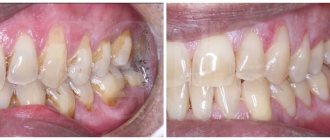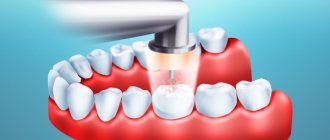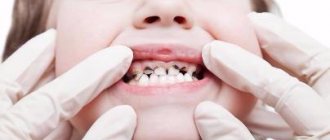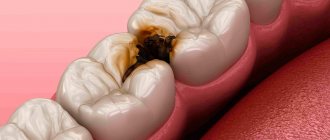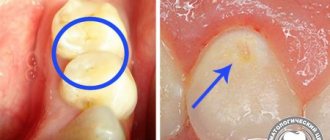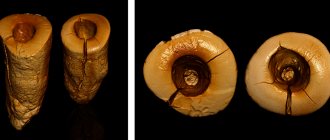Probably, almost every person goes to see a dentist with a feeling of fear and anxiety. Many people put off visiting the dentist until the last minute. They try to cure the tooth on their own or at least relieve the pain with various folk remedies, come up with non-existent reasons why they cannot go to the doctor, etc. However, sooner or later, you will have to go to the dentist. It is better to do this as early as possible in order to detect the disease at an early stage.
Is it painful to treat caries?
One of the most frequently asked questions when going to the dentist is whether it hurts to treat caries. Sitting down in a chair, we warn the doctor that we have a low pain threshold and, in general, we are simply afraid. The doctor will definitely select a drug that will make the treatment comfortable and painless, even in the most difficult cases.
Today, caries can be cured absolutely painlessly.
Treatment
To answer the question whether it is painful or not to treat caries, you need to understand at what stage the disease is. Treatment at the initial stage consists of remineralizing the damaged area of tooth enamel, which naturally does not hurt at all. Even with slight destruction of the enamel, filling is required. At this stage, the procedure can be performed without the use of anesthesia if the patient is willing to endure a little discomfort during drilling of the dental cavity. Subsequent stages of the development of the carious process require thorough treatment, so it is no longer possible to do without anesthesia. A disease such as cervical caries occurs most often in children and people over 30 years of age who do not properly maintain oral hygiene. This kind of caries forms at the interface between the tooth and the gum. Cervical caries is accompanied by increased sensitivity of the tooth to thermal as well as mechanical stimuli. It is characterized by the formation of a small dark spot and the appearance of bad breath. Cervical caries develops very quickly and moves to the root of the tooth. Treatment of such a disease at the initial stage is carried out with the help of a course of therapy; in subsequent stages of the development of the disease, anesthesia, filling, and possibly tooth depulpation will be required. In order not to think about whether it is painful to treat caries, you should immediately contact a dentist if symptoms such as:
- discoloration of tooth enamel;
- the formation of light or dark spots on the tooth;
- the appearance of a tooth reaction to irritants;
- bad breath.
With timely assistance, treatment can be painless and may not require the administration of an anesthetic.
Without anesthesia
In rare cases, doctors have to carry out treatment without anesthesia. This usually happens when there is an allergy to anesthetics. If the patient is intolerant to drugs, the doctor may suggest treatment with laser or chemical reagents. General anesthesia is also an option.
As a rule, the majority of people prefer to undergo treatment under local anesthesia. But there are brave souls who have a high pain threshold or even prefer to do without an injection.
If we are talking about superficial caries, when the tooth tissue is not yet damaged, then this is understandable. But with medium and deep caries, such pain is almost impossible to endure without anesthesia. And it’s not necessary - the latest generation of anesthetics do not cause allergic reactions, they can be used even when treating children and pregnant women.
There is no point in being a hero when treating teeth - without anesthesia it will hurt. And talking about savings also makes no sense.
Anesthesia and sedation in dentistry
If a patient asks for general anesthesia due to panic, then he can be offered sedation. This is an alternative to "deep sleep". Thanks to it, during therapy the person is half asleep and does not feel pain.
Anesthesia is used very rarely in dentistry, only if a serious and complex maxillofacial operation is to be performed. Its use is also relevant if the patient has a low pain sensitivity threshold and is allergic to all local painkillers.
On the front teeth
The main feature of caries on the front teeth is that it develops very quickly. Due to the high load, the enamel quickly becomes thinner, causing tissue destruction to occur at a rapid pace. In advanced cases, severe pain begins, especially while eating. It is also necessary to talk about the aesthetic aspect - caries on the front teeth instantly attracts attention.
It is not painful to treat caries on the front teeth under local anesthesia. Perhaps the doctor will slightly increase the dosage of the drug to completely eliminate sensitivity.
Important. If you notice a spot or initial caries on your front teeth, we recommend that you immediately contact your dentist. If you wait, you risk losing a tooth in the most visible place. And this means additional costs for prosthetics.
Classification according to the depth of the carious process
For a dental therapist involved in the treatment of caries, a topographic classification is more convenient:
- spot stage caries;
- uncomplicated simple caries;
Stain stage caries is the first stage of caries, in which the tooth enamel changes its color due to the formation of a so-called chalky stain on it. At the same time, the tooth remains smooth, since the enamel is still only in the initial stages of destruction. When diagnosing this stage, the most important task of the dentist is to stop the further development of the disease and its transition to the next stages of development.
In the earliest stages of caries, its therapy is considered a fairly simple task, is practically painless, takes a minimum of time (only one visit to the dentist is possible) and, accordingly, the least expensive. At the initial stage of caries, the dentist begins treatment of the tooth with the procedure of removing the stain, after which the enamel is remineralized, while the following preparations are applied to the neck of the tooth: sodium fluoride solution, calcium gluconate and others. Dentists can also use techniques such as infiltration-impregnation.
Superficial caries in the initial stage
At the stage of superficial caries, the surface of a timely undetected and unremoved chalk stain becomes rough due to demineralization of the enamel. In this case, the enamel-dentin junction of the tooth is not yet affected. The tooth at the site of superficial caries begins to hurt from cold food or hot food and may become sensitive to sweet or sour foods.
Treatment for this stage of caries will usually involve grinding down the area of the tooth. After grinding, just as in the case of the treatment of the previous, very first stage of caries, remineralizing therapy is performed.
But, in cases of caries localization in the fissures or on the contact surfaces of the teeth (these areas are the most susceptible to caries, since there are good conditions for food sticking and they are difficult to access for cleansing), then rem therapy becomes ineffective, so the dentist needs to prepare the affected area according to the classical method followed by filling. Superficial caries must be distinguished from such non-carious diseases as erosion of hard tissues and wedge-shaped defects.
Average caries
At the stage of average caries, the lesion begins to penetrate deeper. The enamel-dentin junction is affected, and the dentist can easily determine the deep pathology of the tooth. With average caries, the patient often feels pain, which becomes longer and more intense; pain, as a rule, occurs in the evening and at night, as a result of which the patient’s quality of life suffers greatly. Treatment of caries that has developed to a moderate form consists of removing the damaged part of the tooth and treating it with medications, followed by installing a filling of the desired type.
Deep caries
When, with advanced untreated caries, damage reaches the peripulpal dentin, the stage of deep caries begins. Therapy for deep caries consists of complete removal of the carious part of the tooth, followed by treatment of the damage with medications, the use of remineralizing drugs and filling. In the absence of treatment or inadequate therapy for this pathology, after the destruction of dentin, damage to the pulp occurs - pulpitis, which turns into periodontitis.
Complicated caries (pulpitis, periodontitis)
This classification takes into account the depth of the lesion, which is a determining factor for the choice of treatment method.
Caries in the initial stage (spot stage), superficial caries, medium caries with small defects are not detected on an x-ray. At the same time, it is very important to differentiate caries from other dental pathologies; for example, caries in the spot stage must be separated from such non-carious lesions as hypoplasia and fluorosis.
What these pathologies have in common is the formation of stains on the teeth, EOM (electroodontometry) readings are normal, and the absence of any discomfort. What are the differences: caries, unlike these two pathologies, can be detected when stained with special dyes, fluorosis and hypoplasia occur before teething, and caries always occurs after; caries is found in caries-susceptible areas, and non-carious pathologies in atypical (caries-resistant) areas.
Cervical caries
The majority of patients believe that the treatment of cervical caries is particularly painful. In principle, this is how it is - the cervical zone is characterized by increased sensitivity. Without anesthesia, it will undoubtedly hurt.
Cervical caries can not only be “in plain sight”, but also spread deeper. Therefore, the question of carrying out treatment without anesthesia is not even raised.
Classification of caries by localization
Scientist Black (USA) developed a classification of carious cavities by location:
- Class I: damage to cavities in the area of fissures and natural recesses of the teeth;
- Class II: damage to cavities located on the contact surfaces of small and large molars;
- Class III: damage to cavities located on the contact surfaces of the incisors and canines without involving the cutting edge;
- Class IV: damage to cavities located on the contact surfaces of the incisors and canines, involving the cutting edge and corners;
- Class V: damage to cavities located in the neck area of all groups of teeth;
- Class VI: damage to cavities of atypical localization - the cutting edges of the frontal teeth and the cusps of the chewing teeth.
Average caries
With average caries, not only the enamel is destroyed, but the dentin is also affected. The disease at this stage is practically asymptomatic; sensitivity may occur when biting.
Treatment of average caries takes place with anesthesia, which allows the patient not to experience discomfort and feel absolutely comfortable.
Deep caries
Deep caries is characterized by extensive damage to the hard tissues of the tooth. Painful sensations occur during eating and under the influence of temperatures - the tooth reacts to hot and cold. The carious cavity is separated from the pulp by a thin layer of dentin, which explains the increased sensitivity of the tooth to irritants.
Deep caries cannot be treated without pain relief. The use of anesthetics ensures a comfortable state for the patient during treatment with a complete absence of pain.
Stages of caries development and their symptoms.
Caries is classified according to the degree of manifestation of the destructive process:
- Stage of carious stain. The carious spot is white and pigmented.
There are practically no symptoms at this stage, the process proceeds unnoticed. The patient may notice changes in the condition of the enamel and slightly increased sensitivity to sour, sweet, and salty foods.
- Superficial caries. A small depression or spot with a changed enamel structure is noticeable. Symptoms are blurred, short-term pain may appear in response to a mechanical or taste stimulus.
- Average caries. There is a visible cavity of medium depth into which food debris falls. There are often no symptoms, but there may be short-term pain.
- Deep caries. There is a deep carious cavity filled with food debris and destroyed dentin. May be complicated by pulpitis or periodontitis.
Symptoms: sharp acute pain after eating, or as a reaction to irritants, which goes away after cleansing the cavity. It never radiates, unlike pulpitis.
The transition from one stage to another can be slow, or it can be rapid.
Depending on the location of caries, it can be:
- fissure
- Contact surfaces
- Cervical
- Root
There are also “insidious” types of caries:
- Secondary caries - such caries forms again at the site of already treated caries under a filling, if the filling is broken or the cleaning of the carious cavity was carried out poorly.
- Hidden caries - the process develops under a layer of enamel or in a place difficult to access - in this case it cannot be detected during a visual examination.
- Acute caries is a generalized process of multiple caries, characterized by very rapid development and rapid progression, with pain and disruption of the general condition of the body. Requires urgent treatment.
- Multiple caries is a process in which almost all teeth in the oral cavity are affected.
Why do teeth hurt with caries?
Mostly, painful sensations appear already at the stage of deep caries. In this case, the pulp (nervous tissue of the tooth) is separated from the oral cavity by only a thin layer of dentin and reacts to irritants. Pain appears when brushing teeth, when food gets into a carious cavity, as well as from spicy, sweet, and salty foods.
Under the influence of irritants in the pulp, blood flow increases, which leads to excess pressure on the nerve fibers. The pain goes away quite quickly, immediately after the irritant is removed.
Important. Without treatment, deep caries turns into pulpitis. The inflammatory process affects the nerve fibers, the pain gradually becomes unbearable - constant or throbbing, sharp or dull, localized or spreading.
Causes of dental problems
The occurrence of a problem such as caries is associated with the destructive effect of bacteria on the structure of the teeth. The microflora in the oral cavity includes a huge number of microorganisms. Even proper and thorough brushing of teeth with special means and the use of rinses cannot make the oral cavity completely sterile. The proliferation of pathogenic bacteria begins 2-4 hours after the last cleaning.
What exact reasons can cause tooth damage?
- poor oral care;
- unbalanced diet;
- decline in immunity;
- gastrointestinal diseases;
- avitaminosis;
- insufficient amount of minerals (calcium, fluorine) in drinking water.
Stages of caries
The causes of caries include hereditary factors, the quantity and quality of saliva, and disturbances in protein and mineral metabolism in dental tissues. Oral hygiene plays an important role, as does excessive consumption of sweets. Another factor contributing to the occurrence of caries is a lack of calcium and phosphorus in the diet. Teeth can rapidly deteriorate during pregnancy or after suffering from infectious diseases.
Caries develops gradually. Over time, without treatment, a carious cavity appears in place of an almost invisible spot, which at a certain point begins to increase, affecting an increasing amount of dentin.
Experts distinguish four stages of caries development - carious spot, superficial caries, medium caries, deep caries.
Stages of the disease
There are several stages in the spread of the disease:
- Initial or superficial caries. It begins with the formation of a white spot on the tooth enamel, which gradually darkens and goes deep into the tooth.
- Average caries is manifested by the formation of a carious cavity.
- Deep caries - the disease extends beyond the dentin.
Complications that caries can cause: pulpitis, periodontitis, cyst and gumboil formation. Treatment of these diseases is quite a complex and lengthy process, and the lack of treatment, unfortunately, can sometimes even lead to tooth loss. That is why you need to seek help from a dentist when the very first signs of dental disease develop. In the early stages, caries can be cured absolutely painlessly and even without the use of anesthesia.
Caries in the spot stage
Initial stage of caries. Characterized by the appearance of spots on the enamel. In the demineralized area, damage to the enamel structure is observed. As a rule, patients cannot detect it themselves.
The spot may be white or pigmented. If a brown or black stain is easy to notice, then a coated stain can only be diagnosed using an aqueous solution of methylene blue.
Important. With timely treatment, remineralization therapy can be carried out and tissue can be restored. This is why experts recommend visiting the dentist once every six months - in order to take timely measures and prevent caries from developing.
The carious spot is treated with solutions of sodium fluoride and calcium fluoride. The patient is prescribed vitamins, calcium and phosphorus supplements, and brushing teeth with fluoridated toothpaste is recommended. Your doctor may also recommend a special diet that includes foods high in calcium and certain proteins.
Indications for consultation with a dentist-therapist
To keep your teeth healthy and beautiful until old age, you need to monitor the condition of your teeth and consult a dentist at the first symptoms. For preventive maintenance, people visit the dentist 2 times a year; this approach will help avoid caries and prevent dental problems.
- Advanced diagnostic techniques. NKClinic uses only the most modern devices that allow you to determine the problem with maximum accuracy in order to choose the optimal treatment regimen and save your time. For example, to determine the length of the canal and the phase of the pathological process, an apex locator is used - a high-precision endodontic device.
- Attention to detail. Our professionals strive for excellence in every aspect of dental caries treatment. For example, canal treatment is performed using Ni-Ti instruments, which guarantee complete removal of bacteria. The oral mucosa is protected from the effects of anesthetics using a rubber dam - a latex plate. To prevent re-infection, a hermetic three-dimensional filling is used.
- Comfort at all stages of treatment. We offer our clients: high-quality anesthesia, a cozy environment and entertainment (cinema, music, audiobooks) that will help you relax and avoid unpleasant sensations. The dentist's instruments are hidden from the patient's view to avoid additional stress.
- Expert level treatment. The doctors of our clinic are our pride! All dentists have an excellent education and internships in prestigious educational institutions. Also, NKClinic doctors regularly participate in international scientific conferences. Specialists quickly master new technologies, for example, dental treatment under a microscope, and even create them themselves, registering patents. Many years of practice guarantees flawless execution of even complex manipulations.
Superficial caries
Affects only enamel with damage to the structure and the impossibility of restoration. At this stage, it is already possible for the damaged tooth to react to cold or hot.
Caries affects only the upper part of the tooth, without affecting the dentin. At this stage, treatment is already required. The dentist removes damaged tissue using a drill and installs a filling.
Since caries has not yet affected the tooth tissue, treatment can be carried out without anesthesia. But if you have a low pain threshold or are simply overcome by fear of the drill, you still need to perform local anesthesia.
Consequences of untimely treatment of caries
Many people, faced with changes in the structure of their teeth, doubt whether caries should be treated. Especially often, the question of whether it is necessary to treat caries of baby teeth arises among parents of preschool children. The so-called children's bottle caries, which manifests itself mainly at the age of 2-4 years, is associated with sucking a bottle of milk, formula or compote before bedtime or directly at night.
If you have any doubts about whether it is worth treating small caries, you should familiarize yourself with the possible consequences of ignoring this problem. The rapid progression of the disease is fraught with a number of complications that significantly worsen your quality of life:
- Flux. Serious swelling of the gums and cheeks is one of the most common consequences of advanced dental disease. To find out whether it is painful to treat deep caries with an injection, you will need to ignore its initial symptoms for some time, allowing more serious stages of its development.
- Pulpitis. Inflammation of the dental tissues, accompanied by unbearable pain, is another complication of the disease, when the nerves and blood vessels become inflamed, fester and subsequently die completely.
- Periodontitis. The infection, spreading through the dental canals, spreads to the surrounding tissues, causing their inflammation. Then the inflammatory process intensifies, suppuration and tissue abscess occur.
- Cystic formations. Don't know what will happen if you don't treat caries? One of the most serious consequences of such inaction is the gradual destruction of bone tissue with granulation. The cavities that form at the roots of the teeth turn into cysts located directly in the jaw itself. Filled with pus, they pose a serious danger to human health. To remove the pus and complete cure, you need to puncture and excise the cyst.
Do you want to understand how to treat caries on teeth and between teeth before this disease develops into something more serious and dangerous? You should contact a dental clinic when the first symptoms of the disease appear. It is also important to undergo regular examinations with a doctor to prevent such unpleasant complications. Don’t put off going to the clinic - by doing this you will not only improve the quality of your life, but you will be able to prevent the complete loss of damaged teeth.
Average caries
At the third stage, caries already affects the tooth tissue – dentin. A small carious cavity forms, the tooth begins to bother and hurt. It reacts to cold air entering when talking or breathing, to leftover food, to cold and hot.
The manipulation is carried out under anesthesia, as the patient may experience quite strong pain. Depending on the degree of tissue damage, the dentist selects the necessary treatment. In most cases, the carious cavity is prepared, infected tissue is removed, and filling is performed.
Complaints about aesthetic defects of central teeth
Before
Stage
After
Specialist:
Zakharova Daria Mikhailovna
Patient G., 28 years old, came to the clinic with complaints of an aesthetic defect in the central teeth. Previously, treatment was carried out using a brace system in our clinic. During the examination, the presence of old fillings on 1.1, 2.1 was discovered, the marginal fit was broken, there was a secondary carious process under the fillings, there were no contact points between the teeth. 2.1 tooth was depulped, resulting in darkening of the tooth tissue.
The treatment was carried out under infiltration anesthesia, during which old fillings were removed, carious cavities were prepared, cavities were treated with medication, followed by restoration and restoration of the anatomical shape using paints (to simulate fluorosis) of teeth 1.1,2.1, finishing treatment.
Presence of carious cavity and pain for sweets
Before
Stage
After
Specialist:
Chernenkaya Evgenia Vladimirovna
Patient Ch., 30 years old, came to our clinic with complaints of the presence of a carious cavity and pain in sweets. During the examination, a carious cavity was discovered on tooth 3.7. During treatment, tooth 3.7 was prepared under infiltration anesthesia, drug treatment of the carious cavity followed by restoration of lost tooth tissue using fissure paints to create a more natural result. Finishing processing.
Pain relief during treatment
For local anesthesia, drugs based on articaine and mepivacaine are used. Articaine-type drugs are more effective than novocaine - 5-6 times, lidocaine - 1.5-2 times.
Most anesthetics contain, in addition to the main active ingredient, vasoconstrictor components - adrenaline or epinephrine, which reduce the leaching of the anesthetic, which in turn leads to an increase in the duration of the effect in time and the strength of anesthesia.
Articaine anesthetics include:
Content:
- Where can you cure caries painlessly?
- Types of anesthesia in dentistry
- When not to use local anesthesia
- Anesthesia and sedation in dentistry
- Anesthetics used in dentistry 5.1. Medicines based on aticaine 5.2. Painkillers containing mepivacaine
Is it painful to treat teeth?
This question worries almost any person planning to undergo dental treatment. In fact, the problem of pain relief in dentistry has always been very acute. Almost all medical procedures performed by a specialist cause severe discomfort. Knowing this, people are afraid to treat caries, pulpitis and other oral diseases. But refusal to seek medical help in a timely manner invariably entails another problem - the progression of the existing pathology. After all, dental diseases do not go away on their own. Over time, they become more pronounced and are less responsive to therapy.
Therefore, it is important to prevent the patient from having a negative experience associated with the lack of adequate pain relief. For this purpose, more and more effective anesthetics are being developed every year. Using them in their work, dentists can offer their clients the most comfortable and completely painless dental treatment.
Ultracaine
French drug, available in 1.7 ml carpules in three forms:
- Ultracaine DS forte
– containing 1:100,000 epinephrine. A highly effective anesthetic for operations and treatment of pulpy teeth. Not recommended for patients with thyroid diseases and cardiovascular pathologies. - Ultracaine DS
- with an epinephrine concentration of 1:200,000. Ideal for pain relief in pregnant and lactating women and patients with compensated cardiovascular diseases. - Ultracaine D
– without adrenaline/epinephrine. Used when there is a high risk of allergic manifestations. Can be used by patients with bronchial asthma, cardiovascular pathologies, and thyroid diseases.
The drug can be used starting from the age of four.
Septanest (France)
They are produced in two forms with an adrenaline content of 1:100,000 and 1:200,000. Unlike Ultracaine and Ubistezin, the anesthetic contains preservatives that have a strong allergenic effect.
The drug Scandonest is produced based on mepivacaine. The anesthetic does not contain preservatives or vasoconstrictors. Recommended for anesthesia for pregnant and lactating women suffering from cardiovascular diseases, bronchial asthma and thyroid diseases.
Important. When visiting a dentist, be sure to tell the doctor if you have allergies or chronic diseases. This will help the doctor choose the right anesthetic for you.
Caries, statistics
Data from various studies indicate that in equatorial regions (Africa, Asia) caries is less common than in the northern and polar regions (Scandinavia, North America). People living in developing countries also have a higher incidence of dental caries, but in this case this is not due to genetic predisposition or the influence of external factors, but to a much lower availability of dental care than in developed northern countries.
Caries is of infectious origin associated with the activity of microorganisms such as veyonella, lactobacilli and other microbes. Streptococci play a leading role in the development of dental caries disease.
A decrease in resistance to caries is associated with a decrease in the calcium content of tooth enamel, with a decrease in the calcium/phosphorus ratio, as well as with immune disorders in general. Researchers associate the decrease in the body’s immunity mainly with a decrease in the content of secretory immunoglobulin type “A” in saliva, which prevents the attachment of microorganisms to the surface of tooth enamel and thereby prevents the formation of soft plaque, which, with insufficient hygiene, is susceptible to hardening and the formation of hard tartar.
Will it hurt when I get an injection in the gum?
To administer the anesthetic, special carpule syringes with a very thin needle are used, which minimizes discomfort during the injection. The drug is administered quite slowly, over 40-45 seconds.
In most clinics, before the injection, so-called topical anesthesia is performed using a special anesthetic gel or septic tank. In this case, the specific area of the mucous membrane to which the composition was applied is anesthetized. In this case, the needle entry will be painless.
Types of anesthesia
Methods and painkillers differ significantly in the mechanism of action and the method of administration into the body. The following types of anesthesia are used in the field of therapeutic dentistry:
- Application – involves applying a special gel or spray based on an antiseptic. It is used at the site of an anesthetic injection, removal of dental plaque and when removing baby teeth.
- Infiltration - introducing a dose of anesthetic into the gum tissue by injection. With this injection, the nerve endings are completely blocked. The teeth and adjacent tissues completely lose their sensitivity. Under such anesthesia, it is possible to treat almost any dental disease and even perform minor operations.
- Conduction - this type of anesthesia involves delivering the drug directly to the branch of the trigeminal dental nerve, which blocks the transmission of impulses along the entire length of the nerve. This method is used in areas of dense bone formations of the lower jaw, because it is impossible to administer a direct injection into this area due to the insufficient width of the open mouth. The technique of performing conduction anesthesia is quite complex, and in itself can be painful, but it provides the longest and most lasting effect in the treatment of the lower and upper jaw.
When to see a doctor, symptoms
Don’t delay going to the dentist if you suddenly experience even minor pain. The very fact of pain indicates that caries has begun to develop, which in some cases affects the tooth almost instantly.
When to go to the doctor:
- pain when biting;
- pain from temperature and chemical irritants;
- pain from exposure to cold air.
Without a doubt, the best option is to visit your dentist once every six months in order to take timely measures to prevent the development of caries.
Folk remedies in the fight against dental disease
Want to know how to cure tooth decay at home without a dentist? To help yourself maintain the health and integrity of the dental structure, you should remember how and how caries is treated. You can influence the condition of your teeth and overall well-being by adjusting your diet and taking more careful oral care. By reducing the consumption of sweets and soda, unhealthy foods and fast food, while adding fresh vegetables and fruits to the menu, you can prevent the occurrence and development of the disease.
Various folk remedies used in oral care will help improve the general condition of teeth and strengthen their structure. You can use decoctions of sage, calamus and other herbs for rinsing. In addition, you should rinse your mouth and try to brush your teeth after every meal. In daily hygiene care it is necessary to use special dental floss. It will help remove food debris from the interdental spaces, stopping the proliferation of pathogenic bacteria. You can do all of these preventive procedures at home yourself.
Complications
Teeth do not heal on their own. In any case, you will have to see a doctor, but it is better to do this as soon as possible. If it so happens that for some reason you have delayed this process, be prepared for the fact that caries will turn into pulpitis or periodontitis.
The pain in such cases becomes unbearable - throbbing, pulling, almost incessant. At a certain point, the patient will not even be able to tell which tooth hurts, since the pain can take over the entire jaw and radiate to the eye, ear, and temple.
Get a free examination at a dental clinic
If you doubt the health and normal condition of the oral cavity, it is better to contact a dental clinic for a preventive examination. The dental clinic offers its patients the opportunity to undergo a free examination by a doctor. Here you will learn how caries is treated in dentistry and how much it costs to treat caries of one tooth. Competent consultation with a specialist and provision of answers to all your questions will help you find out how and how long to treat dental caries at the dentist.
The importance of regular examination by a doctor is an undeniable truth. Modern diagnostic and treatment methods used in our clinic will help you fight the most advanced dental problems. Our doctors will answer the question of whether wisdom teeth can be treated for caries and in what cases their removal may be necessary. An individual approach to each patient and attentive attitude to all existing problems will make contacting our center as convenient and comfortable as possible for each of you.
If you have the symptoms described in this article, be sure to make an appointment at our clinic.
Don't self-medicate! Even the smallest problem, if not treated correctly, can significantly complicate your life.
By contacting us, you can be sure that:
- Get high-quality and free consultation .
- You will receive the best prices for treatment and the opportunity to receive a special promotional price.
- Only modern equipment and materials will be used.
- You will be treated by professional doctors with many years of experience.
- We offer treatment on credit or in installments. There is also the possibility of obtaining a tax deduction.
- We work seven days a week and without a lunch break, from 9 a.m. to 10 p.m.
+7 (495) 132-02-96
Make an appointment
